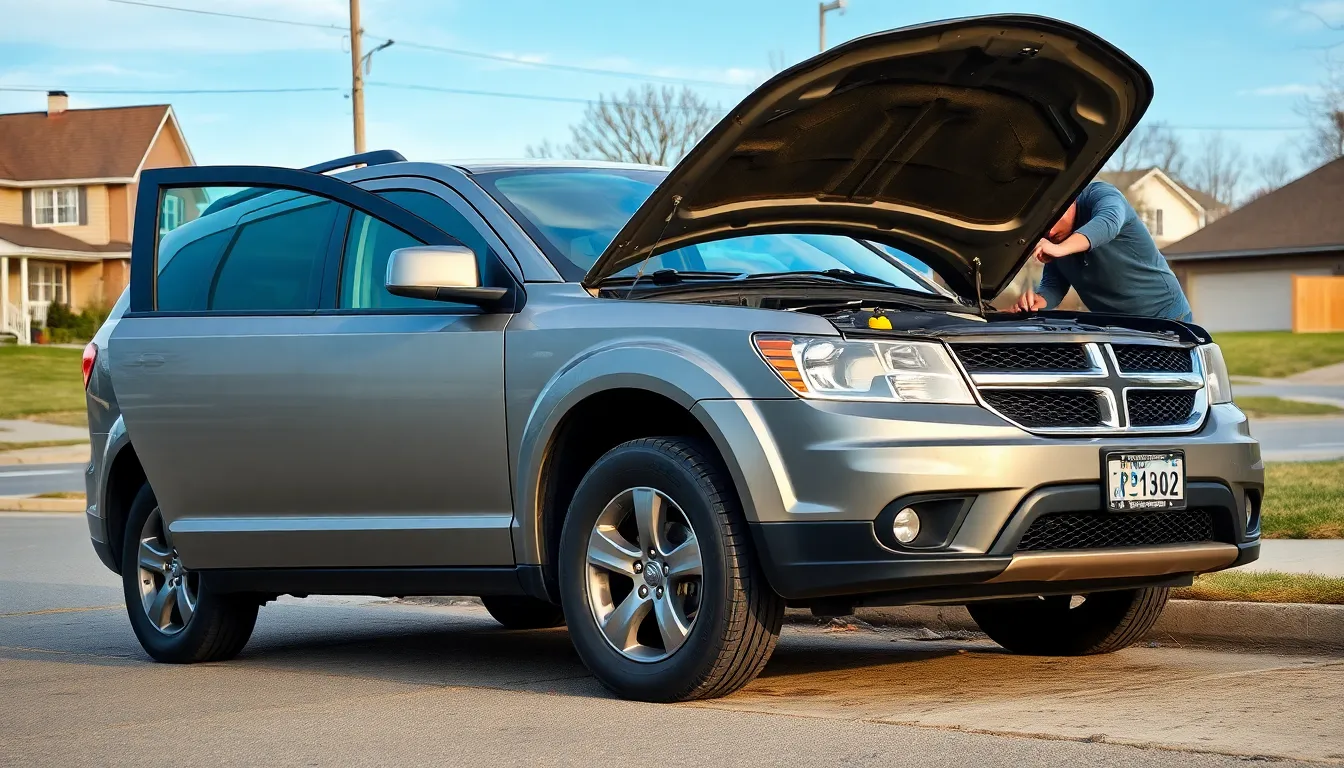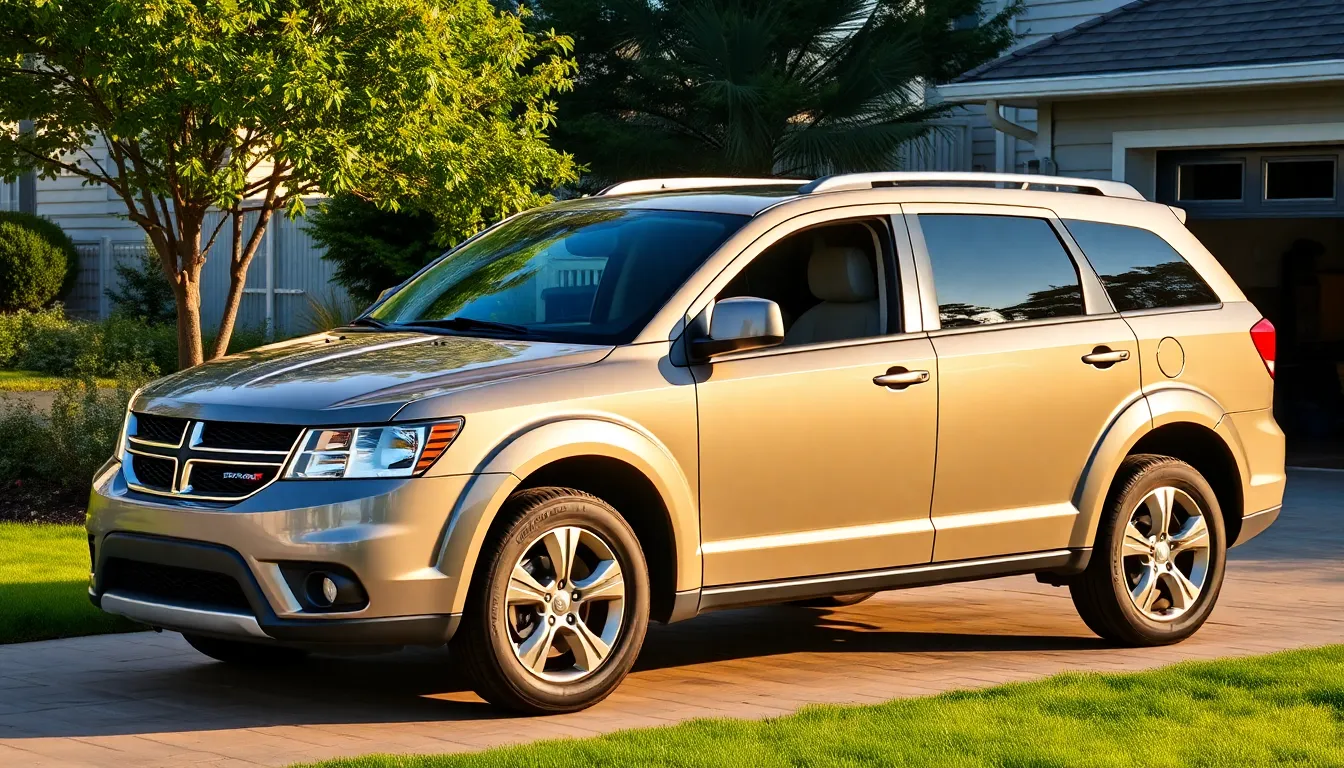Looking for a Dodge Journey but worried about reliability issues? While this midsize crossover SUV offered an affordable family vehicle option from 2009 to 2020, not all model years delivered the same quality and dependability.
When investing in a used Dodge Journey, knowing which years to avoid can save you thousands in unexpected repair costs and countless headaches. Certain model years have developed notorious reputations for transmission failures, electrical problems, and engine issues that might turn your family vehicle into a money pit. Before you sign on the dotted line for that seemingly great deal, let’s explore which Dodge Journey model years should raise red flags during your search.
The Dodge Journey: A Brief Overview
The Dodge Journey made its debut in the North American market in 2009 as Dodge’s entry into the competitive midsize crossover SUV segment. Positioned between the compact Caliber and the larger Durango, this versatile vehicle offered families a budget-friendly option with three-row seating capacity and practical storage answers. Production of the Journey continued until 2020, giving it an 11-year run in Dodge’s lineup.
Throughout its production, the Journey underwent only one important refresh in 2011, which brought updated exterior styling, an improved interior, and Chrysler’s Pentastar V6 engine option. The base models typically featured a 2.4-liter four-cylinder engine, while higher trims offered the more powerful V6 alternative. Transmission options included a four-speed automatic for earlier four-cylinder models and a six-speed automatic for V6 variants.
Even though its affordability and family-friendly features, the Journey developed a reputation for inconsistent reliability across different model years. Many owners appreciated its spacious interior, hidden storage compartments, and available third-row seating. Customer satisfaction surveys revealed that the Journey’s value proposition attracted budget-conscious families, though some, like Tampa resident Mike Peterson, reported feeling “disappointed by recurring electrical issues in my 2010 model that the dealership couldn’t seem to fix.”
The Journey’s sales remained steady throughout most of its production run, with particular success in markets where affordability took precedence over cutting-edge features or performance. By understanding the Journey’s history and evolution, you’re better equipped to identify which model years represent the best value and which might leave you stranded with costly repairs.
Identifying Problematic Model Years of the Dodge Journey

The Dodge Journey’s reliability varies significantly across its production run, with certain model years presenting more frequent and serious issues than others. Understanding these problematic years helps you make an well-informed choice when shopping for a used Journey and potentially saves thousands in unexpected repair costs.
2009-2010: First Generation Issues
The inaugural 2009 and 2010 Dodge Journey models represent the most troublesome years in the vehicle’s history. These first-generation vehicles accumulated the highest number of complaints, featuring premature brake and rotor wear that often required replacement before 30,000 miles. Electrical malfunctions plagued these models, causing unpredictable dashboard behavior, power window failures, and intermittent starting problems. Engine performance issues included rough idling, unexpected power loss during acceleration, and stalling at intersections. Dodge issued multiple recalls for the 2009 model specifically, addressing critical safety concerns like driver’s airbag wiring defects, engine wiring harness fire hazards, and ignition switch problems that disabled key safety systems.
2011-2013: Persistent Transmission Problems
Transmission failures became the defining issue for Dodge Journeys produced between 2011 and 2013. Many owners reported transmission problems emerging surprisingly early, sometimes appearing at just 15,000 miles. Symptoms included difficulty shifting between gears, stiff or erratic shifting behavior during acceleration, and distinctive clunking noises when changing from park to drive. Dodge issued technical service bulletins addressing these concerns, but complaints continued as temporary fixes often failed to resolve underlying mechanical problems. Transmission repairs for these model years typically cost between $2,000-$4,000, making them especially expensive problems for second or third owners who purchased these vehicles used.
2015: Electrical System Concerns
Electrical system failures peaked in the 2015 Dodge Journey models, creating frustrating ownership experiences. Key fob detection problems left many owners stranded in parking lots when their vehicles failed to recognize the presence of the key. Door locks developed minds of their own, sometimes captivating or disengaging randomly or refusing to respond to commands. Starting issues related to electrical system failures became increasingly common around 50,000 miles, requiring dealership intervention. Software updates provided by Dodge sometimes resolved these issues temporarily, but many owners reported persistent problems even after multiple dealer visits. The complexity of modern vehicle electronics made these issues particularly difficult to diagnose properly, leading to repeated repair attempts and mounting frustration for 2015 model owners.
Common Problems in Troubled Dodge Journey Years

The Dodge Journey’s reputation for unreliability stems from several persistent mechanical and electrical issues that plague exact model years. Owners of 2009-2015 Journeys report recurring problems that often result in expensive repairs and important inconvenience.
Engine and Transmission Failures
Transmission problems rank among the most severe issues in troubled Dodge Journey models, particularly in the 2011, 2014, and 2015 versions. Owners frequently experience rough shifting, gear slipping, and complete transmission failure while driving. These transmission malfunctions typically occur without warning and repairs can cost over $3,000, creating important financial strain for many families. Engine failures also plague earlier Journey models, with many owners reporting rough running conditions and unexpected breakdowns that leave them stranded. The frequency of these critical powertrain issues makes the 2009-2014 models especially risky purchases on the used car market.
Electrical System Malfunctions
Electrical failures consistently frustrate Dodge Journey owners across the 2009-2014 model years. Interior accessories stop working without warning, remote keyless entry systems fail, and water leaks inside the cabin damage critical electrical components. These issues extend beyond mere inconvenience, often resulting in multiple dealer visits and complicated diagnostic processes. Electrical problems prove particularly troublesome because they’re difficult to diagnose and repair, with symptoms ranging from dashboard warning lights to complete vehicle immobilization. Many owners express frustration at the seemingly random nature of these electrical gremlins that continue to appear even after attempted repairs.
Suspension and Steering Issues
While not as widely reported as engine or electrical problems, suspension and steering complaints appear regularly in owner feedback for 2009-2014 Journey models. These issues manifest as unusual noises while turning, premature wear of suspension components, and inconsistent steering response. Brake problems compound these concerns, especially in 2009 and 2010 models, where owners report needing replacement brake pads and rotors every three months due to excessive wear. The frequency of these repairs creates ongoing maintenance costs that dramatically exceed what owners of comparable crossover SUVs typically experience. This combination of steering, suspension, and brake issues significantly impacts both the safety perception and ownership satisfaction of affected Journey models.
Most Reliable Dodge Journey Years to Consider

The 2015 to 2019 Dodge Journey models stand out for their exceptional reliability with minimal repairs and fewer customer complaints. These models deliver a dependable mid-size SUV experience without demanding excessive maintenance or repair costs.
Owners particularly praise the 2020 model year as the most reliable in the Journey’s production history. This final iteration received only 17 complaints documented by the National Highway Traffic Safety Administration (NHTSA) and had zero recalls. Most concerns with the 2020 model relate to minor in-car electronics issues such as reversing camera glitches and Bluetooth connectivity problems, which don’t significantly impact overall dependability.
The 2013 and 2016 models also deserve consideration when shopping for a reliable used Journey. These years show marked improvement over earlier iterations, with many of the initial design flaws corrected. Journey owners report these models can exceed 200,000 miles with proper maintenance scheduled at regular intervals.
For maximum value and reliability, focus your search on the 2013, 2016-2019, or 2020 model years. These versions offer the Journey’s spacious interior and practical features without the mechanical headaches associated with earlier models. A thorough pre-purchase inspection remains essential regardless of model year, as individual vehicle history significantly impacts long-term reliability.
How to Identify a Problematic Dodge Journey Before Buying
Examining a used Dodge Journey requires special attention to details that reveal potential problems before they become expensive repairs. Service records tell the complete maintenance story of any Journey you’re considering. Look specifically for documentation of recall completions, especially for 2009-2014 models which had up to eight recalls on some years.
A professional mechanical inspection saves thousands in future repair costs. Have a certified mechanic thoroughly evaluate these key systems:
- Engine components: Check for signs of overheating, which commonly occurs around 78,000 miles in 2009-2016 models due to debris blocking coolant flow
- Transmission function: Ensure smooth shifting through all gears without hesitation or jerking
- Brake system: Inspect for premature wear patterns, as early models (2009-2012) frequently needed replacements sooner than expected
- Electrical connections: Test all accessories, especially the notoriously problematic keyless entry systems
Your test drive reveals issues no inspection alone can find. Listen carefully for rough idling when stopped at lights – a common complaint in 2009-2010 models. Apply brakes at various speeds to detect noise or poor performance. Operate all electronics including climate control, windows, and infotainment systems to verify proper function.
Water intrusion damages electronics and creates mold issues in Dodge Journeys. Carefully inspect the interior carpeting, especially under floor mats, for dampness or musty odors. Check trunk compartments and door seals for signs of leakage, particularly in 2010-2012 models where water leaks inside the cabin were frequently reported.
Newer Dodge Journey models (2018 and later) generally demonstrate improved reliability compared to earlier years. Certified pre-owned vehicles offer additional peace of mind through dealer-backed warranties that cover major systems most prone to failure in problematic years.
Conclusion
Knowing which Dodge Journey years to avoid can save you thousands in repair costs and countless headaches. Steer clear of the problematic 2009-2015 models with their transmission failures electrical issues and engine troubles.
Instead focus your search on the 2016-2020 Journey models which demonstrate significantly improved reliability. The 2020 model stands out as the most dependable option while 2013 and 2016 offer good value with proper maintenance.
Remember to thoroughly inspect any used Journey before purchasing. Check service records request a professional inspection and test all systems during your test drive. A certified pre-owned vehicle with remaining warranty provides additional security for your investment.
With the right model year and proper vetting you can enjoy the Journey’s spacious interior and family-friendly features without the reliability concerns that plagued earlier versions.
Frequently Asked Questions
Which Dodge Journey years should I avoid?
Avoid the 2009-2010 Dodge Journey models, which have the highest complaint rates for premature brake wear and electrical issues. The 2011-2013 models are also problematic due to persistent transmission failures. The 2015 model year is particularly notorious for electrical system failures. Generally, models from 2009-2015 tend to have more reliability concerns than later years.
What are the most reliable Dodge Journey model years?
The most reliable Dodge Journey years are 2016-2020, with the 2020 model being the most dependable with only 17 complaints and no recalls. The 2013 and 2016 models also show significant improvements over earlier versions. Many owners report these models can exceed 200,000 miles with proper maintenance, making them the best value for used car shoppers.
What common problems affect the Dodge Journey?
The most common Dodge Journey problems include transmission failures (particularly in 2011, 2014, and 2015 models), engine issues in earlier models, electrical system malfunctions affecting accessories and keyless entry, and suspension/steering complaints in 2009-2014 models. Transmission repairs can exceed $3,000, making them the most expensive and frustrating issues for owners.
How can I identify a problematic Dodge Journey before buying?
Before purchasing a used Dodge Journey, examine service records for completed recalls (especially 2009-2014 models), get a professional mechanical inspection of engine, transmission, and electrical systems, and take a thorough test drive. Listen for rough idling, check brake performance, operate all electronics, and inspect for water intrusion issues. Consider newer models (2018+) or certified pre-owned vehicles for added reliability.
How long do Dodge Journeys typically last?
With proper maintenance, reliable Dodge Journey models (particularly 2013, 2016-2020) can last over 200,000 miles. However, problematic years like 2009-2010 and 2011-2015 may require significant repairs before reaching high mileage. Regular maintenance including transmission fluid changes, cooling system service, and addressing minor issues promptly can significantly extend your Journey’s lifespan.
Is the Dodge Journey a good family vehicle despite reliability concerns?
The Dodge Journey offers good value as a family vehicle with its three-row seating, spacious interior, and numerous storage solutions at an affordable price point. However, reliability varies significantly by model year. If you choose one of the more reliable years (2016-2020) and maintain it properly, it can serve as a practical family vehicle without excessive repair costs.
